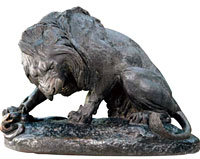Bronze by Barye on Exhibit at MIA
Through January 10, the Minneapolis Institute of Arts (MIA) presents "The Louvre and the Masterpiece", an exhibition that explores how the definition of a "masterpiece," as well as taste and connoisseurship, have changed over time. "The Louvre and the Masterpiece" features sixty-two works of art drawn from all eight of the Musée du Louvre's collection areas, spanning 4,000 years, including a rare, life-sized bronze lion sculpture by Antoine-Louis Barye.
"We are thrilled to present such a magnificent group of works from the Louvre's collections to Minnesota for the first time, and it is a great opportunity to explore what makes a work of art a masterpiece," said Kaywin Feldman, Director and President of the Minneapolis Institute of Arts. A comprehensive selection of paintings, sculpture, decorative arts, and drawings reflect three major themes: the changing historical and cultural definitions of a masterpiece; authenticity and connoisseurship; and the evolution of taste and scholarship.
The show includes an in-depth examination of French sculptor Antoine-Louis Barye's life-sized bronze Lion and Serpent, further elucidating the exhibition's themes, such as the significance of technical mastery and the creative process, and the impact of the artist's reputation. This presentation includes smaller models and studies based on Barye's masterpiece. Barye was well known for his realistic depiction of animals, especially those engaged in life-and-death struggles. Lion and Serpent was commissioned by King Louis-Philippe for the Tuileries Gardens, and was on display there from 1836 to 1911. With Lion and Serpent, Barye pushed the technical boundaries of cast-bronze sculpture by using only one bronze pour into a single mold. He reproduced the work hundreds of times in other sizes, which were then sold as collectible objects and used as diplomatic gifts from the French government.
"What Is a Masterpiece" explores the changing historical definitions of the concept of masterpiece through a selection of objects from the ancient Near East through the mid-19th-century. In the ancient world, a masterpiece was defined by an object's owner and purpose. In contrast, medieval artists achieved technical mastery within specialized guilds. Notable objects in this section include two such inscribed works: a Limoges ciborium (c. A.D. 1200), a vessel used for holding communion hosts, and a Mamluk hammered bronze basin known as the Baptistery of Saint Louis, (c. late 13th-early 14th century). The Baptistery of Saint Louis was later used to baptize Louis XIII in 1610 and Napoleon III's son in 1856.
Resources:
Also in this Issue:
- Meet the Signature Copper Artists of Artist House
- J Crocker Designs: Shedding an Eco Friendly Light on Copper
- Roland Hockett: Experiments with Copper
- The Wurlitzer Brass Pipe Organ Revival at the City Museum
- Bronze by Barye on Exhibit at MIA

